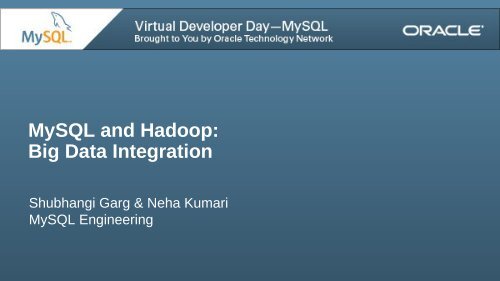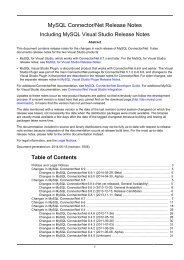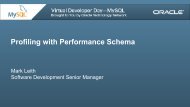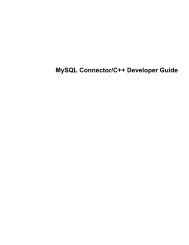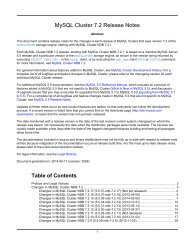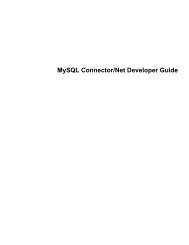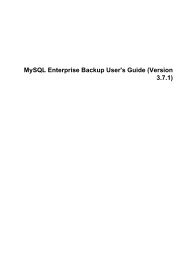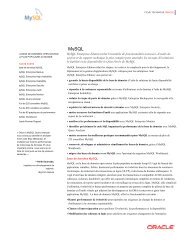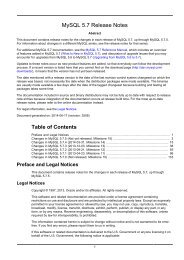Presentation (PDF) - MySQL
Presentation (PDF) - MySQL
Presentation (PDF) - MySQL
You also want an ePaper? Increase the reach of your titles
YUMPU automatically turns print PDFs into web optimized ePapers that Google loves.
<strong>MySQL</strong> and Hadoop:<br />
Big Data Integration<br />
Shubhangi Garg & Neha Kumari<br />
<strong>MySQL</strong> Engineering<br />
1Copyright © 2013, Oracle and/or its affiliates. All rights reserved. Insert Information Protection Policy Classification from Slide 12
Agenda<br />
<br />
<br />
<br />
<br />
<br />
<br />
<br />
Design rationale<br />
Implementation<br />
Installation<br />
Schema to Directory Mappings<br />
Integration with Hive<br />
Roadmap<br />
Q&A<br />
2Copyright © 2013, Oracle and/or its affiliates. All rights reserved. Insert Information Protection Policy Classification from Slide 12
Safe Harbor Statement<br />
The following is intended to outline our general product direction. It is intended<br />
for information purposes only, and may not be incorporated into any contract.<br />
It is not a commitment to deliver any material, code, or functionality, and<br />
should not be relied upon in making purchasing decision. The development,<br />
release, and timing of any features or functionality described for Oracle’s<br />
products remains at the sole discretion of Oracle.<br />
3Copyright © 2013, Oracle and/or its affiliates. All rights reserved. Insert Information Protection Policy Classification from Slide 12
Big Data: Strategic Transformation<br />
From<br />
4Copyright © 2013, Oracle and/or its affiliates. All rights reserved. Insert Information Protection Policy Classification from Slide 12
CIO & Business Priority<br />
Web recommendations<br />
Sentiment Analysis<br />
Marketing Campaign Analysis<br />
Customer Churn Modeling<br />
Fraud Detection<br />
Research and Development<br />
Risk Modeling<br />
Machine Learning<br />
90% with Pilot Projects<br />
at end of 2012<br />
Poor Data Costs<br />
35% in Annual<br />
Revenues<br />
10% Improvement<br />
in Data Usability<br />
Drives $2bn in<br />
Revenue<br />
5Copyright © 2013, Oracle and/or its affiliates. All rights reserved. Insert Information Protection Policy Classification from Slide 12
CIO & Business Priority<br />
US HEALTH CARE<br />
MANUFACTURING<br />
GLOBAL PERSONAL<br />
LOCATION DATA<br />
EUROPE PUBLIC<br />
SECTOR ADMIN<br />
US RETAIL<br />
Increase industry<br />
value per year by<br />
$300 B<br />
Decrease dev.,<br />
assembly costs by<br />
–50%<br />
Increase service<br />
provider revenue by<br />
$100 B<br />
Increase industry<br />
value per year by<br />
€250 B<br />
Increase net<br />
margin by<br />
60+%<br />
“In a big data world, a competitor that fails to<br />
sufficiently develop its capabilities will be left behind.”<br />
McKinsey Global Institute<br />
6Copyright © 2013, Oracle and/or its affiliates. All rights reserved. Insert Information Protection Policy Classification from Slide 12
Analysts on Big Data<br />
“The area of greatest interest to<br />
my clients is Big Data and its role in<br />
helping businesses understand<br />
customers better.”<br />
Michael Maoz, Gartner<br />
“Big Data Will Help Shape Your<br />
Market’s Next Big Winners.”<br />
Brian Hopkins, Forrester<br />
“Almost half of IT departments in<br />
enterprises in North America,<br />
Europe and Asia-Pacific plan to<br />
invest in Big Data analytics in the<br />
near future.”<br />
Tony Baer, Ovum<br />
“CIOs will need to be realistic about<br />
their approach to 'Big Data' analytics<br />
and focus on specific use cases<br />
where it will have the biggest<br />
business impact.”<br />
Philip Carter, IDC<br />
7Copyright © 2013, Oracle and/or its affiliates. All rights reserved. Insert Information Protection Policy Classification from Slide 12
What Makes it Big Data<br />
PROBLEM: Exceeds limits of conventional systems<br />
SOCIAL<br />
BLOG<br />
SMART<br />
METER<br />
101100101001<br />
001001101010<br />
101011100101<br />
010100100101<br />
VOLUME VELOCITY VARIETY<br />
VARIABILITY<br />
8Copyright © 2013, Oracle and/or its affiliates. All rights reserved. Insert Information Protection Policy Classification from Slide 12
What’s Changed<br />
• Enablers<br />
– Digitization – *nearly* everything has a digital heartbeat<br />
– Now practical to store much larger data volumes (distributed file systems)<br />
– Now practical to process much larger data volumes (parallel processing)<br />
• Why is this different from BI/DW<br />
– Business formulated questions to ask upfront<br />
– Drove what was data collected, data model, query design<br />
Big Data Complements Traditional Methods:<br />
Enables what-if analysis, real-time discovery<br />
9Copyright © 2013, Oracle and/or its affiliates. All rights reserved. Insert Information Protection Policy Classification from Slide 12
Unlocking Value of ALL Data<br />
Big Data:<br />
Decisions based on all your data<br />
Video and Images<br />
Documents<br />
Social Data<br />
Machine-Generated Data<br />
Traditional Architecture:<br />
Decisions based on database data<br />
Transactions<br />
10Copyright © 2013, Oracle and/or its affiliates. All rights reserved. Insert Information Protection Policy Classification from Slide 12
Why Hadoop<br />
Scales to thousands of nodes, TB of structured and<br />
unstructured data<br />
– Combines data from multiple sources, schemaless<br />
– Run queries against all of the data<br />
Runs on commodity servers, handle storage and processing<br />
Data replicated, self-healing<br />
Initially just batch (Map/Reduce) processing<br />
– Extending with interactive querying, via Apache Drill, Cloudera<br />
Impala, Stinger etc.<br />
11Copyright © 2013, Oracle and/or its affiliates. All rights reserved. Insert Information Protection Policy Classification from Slide 12
<strong>MySQL</strong> + Hadoop:<br />
Unlocking the Power of Big Data<br />
50% of our users integrate with <strong>MySQL</strong>*<br />
Download the <strong>MySQL</strong> Guide to Big Data:<br />
http://www.mysql.com/why-mysql/white-papers/mysql-and-hadoop-guide-to-big-data-integration/<br />
*Leading Hadoop Vendor<br />
12Copyright © 2013, Oracle and/or its affiliates. All rights reserved. Insert Information Protection Policy Classification from Slide 12
Leading Use-Case, On-Line Retail<br />
Users<br />
Browsing<br />
Recommendations<br />
Profile,<br />
Purchase<br />
History<br />
Social media updates<br />
Preferences<br />
Brands “Liked”<br />
Web Logs:<br />
Pages Viewed<br />
Comments Posted<br />
Recommendations<br />
Telephony Stream<br />
13Copyright © 2013, Oracle and/or its affiliates. All rights reserved. Insert Information Protection Policy Classification from Slide 12
<strong>MySQL</strong> Applier for Hadoop: Big Data Lifecycle<br />
DECIDE<br />
ACQUIRE<br />
ANALYZE<br />
ORGANIZE<br />
14Copyright © 2013, Oracle and/or its affiliates. All rights reserved. Insert Information Protection Policy Classification from Slide 12
<strong>MySQL</strong> in the Big Data Lifecycle<br />
BI Solutions<br />
DECIDE<br />
ACQUIRE<br />
Applier<br />
ANALYZE<br />
ORGANIZE<br />
15Copyright © 2013, Oracle and/or its affiliates. All rights reserved. Insert Information Protection Policy Classification from Slide 12
Apache Sqoop<br />
• Apache TLP, part of Hadoop project<br />
• Developed by Cloudera<br />
• Bulk data import and export<br />
• Between Hadoop (HDFS) and external data stores<br />
• JDBC Connector architecture<br />
• Supports plug-ins for specific functionality<br />
• “Fast Path” Connector developed for <strong>MySQL</strong><br />
16Copyright © 2013, Oracle and/or its affiliates. All rights reserved. Insert Information Protection Policy Classification from Slide 12
Importing Data<br />
Submit Map Only Job<br />
Sqoop Import<br />
Gather Metadata<br />
Sqoop Job<br />
Map<br />
HDFS<br />
Storage<br />
Map<br />
Transactional<br />
Data<br />
Map<br />
Map<br />
Hadoop Cluster<br />
17Copyright © 2013, Oracle and/or its affiliates. All rights reserved. Insert Information Protection Policy Classification from Slide 12
Ensure Proper Design<br />
Performance impact: bulk transfers to and from<br />
operational systems<br />
Complexity: configuration, usage, error reporting<br />
18Copyright © 2013, Oracle and/or its affiliates. All rights reserved. Insert Information Protection Policy Classification from Slide 12
<strong>MySQL</strong> Applier for Hadoop<br />
Real-Time Event Streaming<br />
<strong>MySQL</strong> to HDFS<br />
19Copyright © 2013, Oracle and/or its affiliates. All rights reserved. Insert Information Protection Policy Classification from Slide 12
New: <strong>MySQL</strong> Applier for Hadoop<br />
Real-time streaming of events from<br />
<strong>MySQL</strong> to Hadoop<br />
– Supports move towards “Speed of<br />
Thought” analytics<br />
Connects to the binary log, writes events<br />
to HDFS via libhdfs library<br />
Each database table mapped to a Hive<br />
data warehouse directory<br />
Enables eco-system of Hadoop tools to<br />
integrate with <strong>MySQL</strong> data<br />
See dev.mysql.com for articles<br />
Available for download now<br />
– labs.mysql.com<br />
20Copyright © 2013, Oracle and/or its affiliates. All rights reserved. Insert Information Protection Policy Classification from Slide 12
<strong>MySQL</strong> Applier for Hadoop: Basics<br />
Replication Architecture<br />
21Copyright © 2013, Oracle and/or its affiliates. All rights reserved. Insert Information Protection Policy Classification from Slide 12
<strong>MySQL</strong> Applier for Hadoop: Basics<br />
What is <strong>MySQL</strong> Applier for Hadoop <br />
– An utility which will allow you to transfer data from <strong>MySQL</strong> to HDFS.<br />
– Reads binary log from server on a real time basis<br />
– Uri for connecting to HDFS: const *uri= “hdfs://user@localhost:9000”;<br />
– Network Transport: const *uri= “mysql://root@127.0.0.1:3306”;<br />
Decode binary log events<br />
– Contain code to decode the events<br />
– Uses the user defined content handler, and if nothing is specified then the default<br />
one in order to process events<br />
– Cannot handle all events<br />
Event Driven API<br />
22Copyright © 2013, Oracle and/or its affiliates. All rights reserved. Insert Information Protection Policy Classification from Slide 12
<strong>MySQL</strong> Applier for Hadoop: Basics<br />
Event driven API: Content Handlers<br />
23Copyright © 2013, Oracle and/or its affiliates. All rights reserved. Insert Information Protection Policy Classification from Slide 12
<strong>MySQL</strong> Applier for Hadoop: Implementation<br />
•Replicates rows inserted into a table in <strong>MySQL</strong> to Hadoop Distributed File System<br />
•Uses an API provided by libhdfs, a C library to manipulate files in HDFS<br />
•The library comes pre-compiled with Hadoop Distributions<br />
•Connects to the <strong>MySQL</strong> master (or reads the binary log generated by <strong>MySQL</strong>) to:<br />
•Fetch the row insert events occurring on the master<br />
•Decode these events, extracting data inserted into each field of the row<br />
•Separate the data by the desired field delimiters and row delimiters<br />
•Use content handlers to get it in the format required<br />
•Append it to a text file in HDFS<br />
24Copyright © 2013, Oracle and/or its affiliates. All rights reserved. Insert Information Protection Policy Classification from Slide 12
Installation: Pre-requisites<br />
Hadoop Applier package from http://labs.mysql.com<br />
Hadoop 1.0.4 or later<br />
Java version 6 or later (since Hadoop is written in Java)<br />
libhdfs (it comes pre compiled with Hadoop distros)<br />
Cmake 2.6 or greater<br />
Libmysqlclient 5.6<br />
Openssl<br />
Gcc 4.6.3<br />
<strong>MySQL</strong> Server 5.6<br />
FindHDFS.cmake (cmake file to find libhdfs library while compiling)<br />
FindJNI.cmake (optional, check if you already have one):<br />
$locate FindJNI.cmake<br />
Hive (optional)<br />
25Copyright © 2013, Oracle and/or its affiliates. All rights reserved. Insert Information Protection Policy Classification from Slide 12
Installation: Steps<br />
Download a copy of Hadoop Applier from http://labs.mysql.com<br />
Download a Hadoop release, configure dfs to set the append property true<br />
(flag dfs.support.append)<br />
Set the environment variable $HADOOP_HOME<br />
Ensure that 'FindHDFS.cmake' is in the CMAKE_MODULE_PATH<br />
libhdfs being JNI based, JNI header files and libraries are also required<br />
Build and install the library 'libreplication', using cmake<br />
Set the CLASSPATH<br />
$export PATH= $HADOOP_HOME/bin:$PATH<br />
$export CLASSPATH= $(hadoop classpath)<br />
Compile by the command “make happlier” on the terminal.<br />
This will create an executable file in the mysql2hdfs directory in the repository<br />
26Copyright © 2013, Oracle and/or its affiliates. All rights reserved. Insert Information Protection Policy Classification from Slide 12
Integration with HIVE<br />
Hive runs on top of Hadoop. Install HIVE<br />
on the hadoop master node<br />
Set the default datawarehouse directory<br />
same as the base directory into which<br />
Hadoop Applier writes<br />
Create similar schema's on both <strong>MySQL</strong> &<br />
Hive<br />
Timestamps are inserted as first field in<br />
HDFS files<br />
Data is stored in 'datafile1.txt' by default<br />
The working directory is<br />
base_dir/db_name.db/tb_name<br />
SQL Query<br />
CREATE TABLE t (i<br />
INT);<br />
Hive QL<br />
CREATE TABLE t<br />
( time_stamp INT, i<br />
INT)<br />
[ROW FORMAT<br />
DELIMITED]<br />
STORED AS<br />
TEXTFILE;<br />
27Copyright © 2013, Oracle and/or its affiliates. All rights reserved. Insert Information Protection Policy Classification from Slide 12
Mapping Between <strong>MySQL</strong> and HDFS Schema<br />
28Copyright © 2013, Oracle and/or its affiliates. All rights reserved. Insert Information Protection Policy Classification from Slide 12
Hadoop Applier in Action<br />
Run hadoop dfs (namenode and datanode)<br />
Start a <strong>MySQL</strong> server as master with row based<br />
replication<br />
For ex: using mtr:<br />
$<strong>MySQL</strong>-5.6/mysql-test$./mtr --start –suite=rpl<br />
--mysqld=-binlog_format='ROW' –mysqld=--<br />
binlog_checksum=NONE<br />
Start hive (optional)<br />
Run the executable ./happlier<br />
$./happlier [mysql-uri] [hdfs-uri]<br />
Data being replicated can be controlled by command<br />
line options.<br />
$./happlier –help<br />
Find the demo here:<br />
http://www.youtube.com/watch<br />
feature=player_detailpage&v=mZRAtCu3M1g<br />
Options<br />
-r, --field-delimiter=DELIM<br />
Use<br />
String separating the fields<br />
in a row<br />
-w, --row-delimiter=DELIM String separating the rows<br />
of a table<br />
-d, --databases=DB_LIST<br />
Ex: d=db_name1-table1-<br />
table2,dbname2-<br />
table1,dbname3<br />
-f, --fields=LIST<br />
-h, --help<br />
Import entries for some<br />
databases, optionally<br />
include only specified<br />
tables.<br />
Import entries for some<br />
fields only in a table<br />
Display help<br />
29Copyright © 2013, Oracle and/or its affiliates. All rights reserved. Insert Information Protection Policy Classification from Slide 12
Future Road Map – Under Consideration<br />
Support all kinds of events occurring on the <strong>MySQL</strong> master<br />
Support binlog checksums and GTID's, the new features in <strong>MySQL</strong><br />
5.6 GA<br />
Considering support for DDL's<br />
Considering support for updates and deletes<br />
Leave comments on the blog !<br />
http://innovating-technology.blogspot.co.uk/2013/04/mysql-hadoop-applier-part-2.html<br />
30Copyright © 2013, Oracle and/or its affiliates. All rights reserved. Insert Information Protection Policy Classification from Slide 12
<strong>MySQL</strong> in the Big Data Lifecycle<br />
DECIDE<br />
Analyze<br />
Export Data<br />
Decide<br />
ANALYZE<br />
31Copyright © 2013, Oracle and/or its affiliates. All rights reserved. Insert Information Protection Policy Classification from Slide 12
Analyze Big Data<br />
32Copyright © 2013, Oracle and/or its affiliates. All rights reserved. Insert Information Protection Policy Classification from Slide 12
Summary<br />
• <strong>MySQL</strong> + Hadoop: proven big data pipeline<br />
• Real-Time integration: <strong>MySQL</strong> Applier for Hadoop<br />
• Perfect complement for Hadoop interactive query tools<br />
Integrate for Insight<br />
33Copyright © 2013, Oracle and/or its affiliates. All rights reserved. Insert Information Protection Policy Classification from Slide 12
Next Steps<br />
34Copyright © 2013, Oracle and/or its affiliates. All rights reserved. Insert Information Protection Policy Classification from Slide 12
Thank you!<br />
35Copyright © 2013, Oracle and/or its affiliates. All rights reserved. Insert Information Protection Policy Classification from Slide 12


